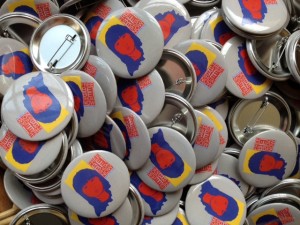 Bei Bei Shuai’s suicide attempt was unsuccessful, and so was her pregnancy. She now faces murder charges. After ingesting rat poison trying to end her own life, she was hospitalized, and a Caesarian later performed on the 33 week old fetus. The baby died in the hospital within a few days. Given these tragic facts and Indiana’s criminal prosecution, the case has attracted widespread attention and advocacy on behalf of Bei Bei Shuai.
Bei Bei Shuai’s suicide attempt was unsuccessful, and so was her pregnancy. She now faces murder charges. After ingesting rat poison trying to end her own life, she was hospitalized, and a Caesarian later performed on the 33 week old fetus. The baby died in the hospital within a few days. Given these tragic facts and Indiana’s criminal prosecution, the case has attracted widespread attention and advocacy on behalf of Bei Bei Shuai.
With trial imminent, the judge is reportedly taking steps to maintain courtroom decorum, including stating:
The wearing of pins, buttons, signs, clothing, and similar materials in the courtroom which express support for or against either party in this case is prohibited.
But doesn’t the public have a First Amendment right to expression in a public trial?
Maybe not.
The United States Supreme Court obliquely confronted the issue in 2006 in Carey v. Musladin. However, in Musladin, the convicted defendant argued that spectators wearing buttons with photos of the victim denied him a fair trial. The Court’s opinion was decisively procedural, centering on habeas corpus standards of relief. While the opinion was unanimous, Justice Souter’s concurring opinion contended that trial judges had affirmative obligations to ensure a fair trial, including regulating the attire of spectators. Souter raised the possibility of the spectators’ First Amendment right to wear buttons, although he stated he did not find such an interest “intuitively strong.”
In the context of support for a victim, the defendant’s constitutional rights to a fair trial should trump. As I discuss in chapter 5 of Dressing Constitutionally, a trial judge in a New York homicide trial banned the wearing of “obtrusive corsages of red and black ribbons of approximately five to six inches in length” in People v. Pennisi. Applying the local courtroom decorum rules prohibiting disruptive conduct, the trial judge used his discretionary power to prohibit all expressive or symbolic clothing and accessories, including armbands, buttons, and flowers, as “disruptive of a courtroom environment, which environment must be scrupulously dedicated to the appearance as well as the reality of fairness and equal.” The judge criticized his own past practice in a non-jury trial permitting thirty-five spectators wearing bright yellow tee shirts bearing the blue legend “Justice for Jimmy,” the victim. Other cases allowing the banning of courtroom spectator attire include banning anti-rape buttons, MAAD (Mothers Against Drunk Driving) buttons, and spectators wearing prison guard uniforms in a prosecution for murder of a prison guard.
While the vast majority of spectator attire seems to favor the victim and thus possibly prejudice the defendant’s right to a fair trial, the high profile ‘Central Park Jogger’ criminal prosecution also involved a spectator button ban. The trial judge “barred a spectator-brother of one of defendants from wearing a black sweatshirt with the letters emblemized in white, ‘My Brother Antron McCray Is Innocent.’”
Of course, as it turned out, the button was correct; the Central Park 5, including Antron McCray, were indeed, innocent.
